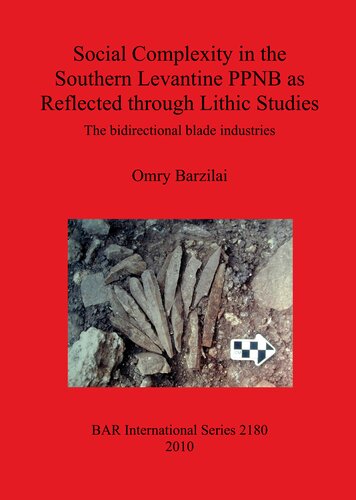

Most ebook files are in PDF format, so you can easily read them using various software such as Foxit Reader or directly on the Google Chrome browser.
Some ebook files are released by publishers in other formats such as .awz, .mobi, .epub, .fb2, etc. You may need to install specific software to read these formats on mobile/PC, such as Calibre.
Please read the tutorial at this link: https://ebookbell.com/faq
We offer FREE conversion to the popular formats you request; however, this may take some time. Therefore, right after payment, please email us, and we will try to provide the service as quickly as possible.
For some exceptional file formats or broken links (if any), please refrain from opening any disputes. Instead, email us first, and we will try to assist within a maximum of 6 hours.
EbookBell Team

5.0
68 reviewsThe aims of this research are two-fold. First is to present and systematically analyze the bidirectional flint blade industries from PPNB sites throughout the southern Levant. This formal 'hallmark' PPNB technology is only briefly reported in most publications, thus requiring some sort of quantification methods, such as indices for formal lithic technologies as has been done, for example, in Palaeolithic research. Broadly, the principles of indices could be employed for the bidirectional blade component; however this is inapplicable for this research since the studied samples include only complete items, thus requiring counts of complete items within the general assemblages, something not presented in most reports. Therefore the bidirectional blade component within the examined provinces are presented by their major characteristics (mode of production, raw material, technology, typology and style) in respect to sample size. The other aim is to examine two of the models discussed, 'Regionalism' and 'Craftspecialization. With regards to 'Regionalism' the author examines whether the proposed cultural units for the southern Levant region are also reflected in the bidirectional blade industries. The focus is on the area from the Litani River in the north to the Gulf of Aqaba in the south, the Transjordanian highlands to the east and the Mediterranean coast in the west. The investigation of aspects of the bidirectional blade lithic industries should complement other material culture such as architecture, burial customs and subsistence economy, amongst others, in contributing to the identification of cultural units in time and space with the southern Levant. The issue of 'Craft specialization' is examined to consider whether complex lithic economies such as the one described for 'Ain Ghazal can be identified at other sites in the southern Levant. The results are further correlated with site types (e.g. permanent and seasonal villages, ephemeral camps, ritual sites) in an attempt to detect possible inter and intra-site patterns for bidirectional blade products, and in order to provide a wider perspective on PPNB social complexity. The proposed research aims to characterize and define the nature and variability of the use of bidirectional blade technology through time and space. It is expected to provide information concerning aspects of social structure and complexity amongst the PPNB communities in the southern Levant before the rise of early urban civilizations in the Near East.